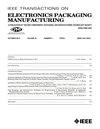The Bond Strength of Au/Si Eutectic Bonding Studied by IR Microscope
IEEE Transactions on Electronics Packaging Manufacturing
Pub Date : 2010-01-01
DOI:10.1109/TEPM.2009.2035307
引用次数: 13
Abstract
The interface of Au/Si(100) eutectic bonding was investigated by infrared (IR) microscope and related to the bond strength. A strong relationship between the IR images and the bond strengths was found. Bond strength test showed that a strong bond has many square black spots in the IR images, whereas a poor bond has fewer or no square black spots. In order to study the nature of the relationship, the dissolution behavior of the bare Si(100) surface after bonding was investigated. During the Au/Si(100) eutectic reaction, the dissolution of the bare Si(100) surface primarily occurs by the formation of the craters which result in many square black spots in the IR images. The formation of the craters is ascribed to the anisotropic nature of Au/Si reaction that results in three-dimensional dissolution behavior on the bare Si(100) side. In order to further test the anisotropy hypothesis, Au/Si(111) bonding was also studied. Under the same bonding conditions, triangular black spots were observed in the IR images and triangular pits were found on the bare Si(111) surface. The analysis suggests that the craters on the bare Si(100) surface, in other words the square black spots in the IR images, are the indication of Au/Si(100) eutectic reaction. More craters mean a reaction between Au and Si(100), which occurs uniformly at the Au/Si(100) bonding interface compared to the case of fewer craters. No crater indicates that there is no eutectic reaction in the region. Therefore, the IR microscope may be used to evaluate and compare the different bond strengths qualitatively.红外显微镜下Au/Si共晶键合强度的研究
采用红外显微镜对Au/Si(100)共晶键合界面进行了研究,并与键合强度进行了相关分析。发现红外图像与键强度之间有很强的关系。结合强度测试表明,强结合在红外图像中有许多方形黑点,而弱结合在红外图像中有较少或没有方形黑点。为了研究这种关系的本质,研究了裸Si(100)表面在键合后的溶解行为。在Au/Si(100)共晶反应过程中,裸露的Si(100)表面的溶解主要是通过形成陨石坑而发生的,这些陨石坑在红外图像中导致许多方形黑点。陨石坑的形成归因于Au/Si反应的各向异性,导致裸Si(100)侧的三维溶解行为。为了进一步验证各向异性假设,还研究了Au/Si(111)键合。在相同的键合条件下,红外图像中观察到三角形黑点,裸露的Si(111)表面出现三角形凹坑。分析表明,裸露的Si(100)表面的凹坑,即红外图像中的方形黑点,是Au/Si(100)共晶反应的指示。陨石坑越多意味着Au和Si(100)之间的反应,与较少陨石坑的情况相比,在Au/Si(100)键合界面上反应均匀。没有陨石坑表明该区域没有共晶反应。因此,可以利用红外显微镜对不同的粘结强度进行定性评价和比较。
本文章由计算机程序翻译,如有差异,请以英文原文为准。
求助全文
约1分钟内获得全文
求助全文

 求助内容:
求助内容: 应助结果提醒方式:
应助结果提醒方式:


